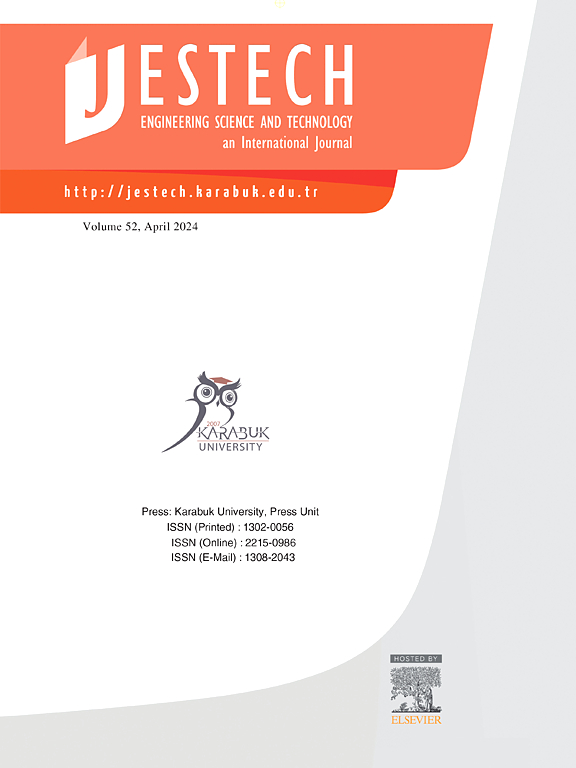Etching-free fabrication method for silver nanowires-based SERS sensors for enhanced molecule detection
IF 5.4
2区 工程技术
Q1 ENGINEERING, MULTIDISCIPLINARY
Engineering Science and Technology-An International Journal-Jestech
Pub Date : 2024-11-16
DOI:10.1016/j.jestch.2024.101892
引用次数: 0
Abstract
Surface-enhanced Raman spectroscopy (SERS) has garnered increasing attention for its ability to detect molecules even at low concentrations; however, the fabrication methods for SERS sensors require further study aimed at simple and rapid on-body and environmental monitoring. In this context, we propose an etching-free method for fabricating silver nanowires (AgNWs)-SERS sensors based on AgNWs. A lift-off process was conducted to create a pattern without etching, and lamination of the dry film resist overcame the limitations associated with liquid photoresists. Consequently, the resulting AgNW-patterned substrate was used to evaluate the pH of the test solution in the range of 1.1 and 12.0 and exhibited a Raman signal enhancement of 2 × 106. This fast and cost-effective fabrication method, combined with the intrinsic flexibility of the substrate and rapid and reproducible response to pH variations, provides a foundation for applying AgNW-patterned substrates for microenvironmental analysis or developing wearable optical devices.
用于增强分子检测的银纳米线 SERS 传感器的免蚀刻制造方法
表面增强拉曼光谱(SERS)因其即使在低浓度下也能检测分子的能力而日益受到关注;然而,SERS 传感器的制造方法需要进一步研究,以实现简单、快速的体内和环境监测。在此背景下,我们提出了一种基于银纳米线(AgNWs)的无蚀刻银纳米线(AgNWs)-SERS 传感器制作方法。我们采用了一种无需蚀刻的剥离工艺来创建图案,干膜抗蚀剂的层压克服了与液态光刻胶相关的限制。因此,得到的 AgNW 图案基底可用于评估 1.1 和 12.0 范围内测试溶液的 pH 值,并显示出 2 × 106 的拉曼信号增强。这种快速、低成本的制造方法,加上基底固有的灵活性以及对 pH 值变化快速、可重复的响应,为将 AgNW 图案基底应用于微环境分析或开发可穿戴光学设备奠定了基础。
本文章由计算机程序翻译,如有差异,请以英文原文为准。
求助全文
约1分钟内获得全文
求助全文
来源期刊

Engineering Science and Technology-An International Journal-Jestech
Materials Science-Electronic, Optical and Magnetic Materials
CiteScore
11.20
自引率
3.50%
发文量
153
审稿时长
22 days
期刊介绍:
Engineering Science and Technology, an International Journal (JESTECH) (formerly Technology), a peer-reviewed quarterly engineering journal, publishes both theoretical and experimental high quality papers of permanent interest, not previously published in journals, in the field of engineering and applied science which aims to promote the theory and practice of technology and engineering. In addition to peer-reviewed original research papers, the Editorial Board welcomes original research reports, state-of-the-art reviews and communications in the broadly defined field of engineering science and technology.
The scope of JESTECH includes a wide spectrum of subjects including:
-Electrical/Electronics and Computer Engineering (Biomedical Engineering and Instrumentation; Coding, Cryptography, and Information Protection; Communications, Networks, Mobile Computing and Distributed Systems; Compilers and Operating Systems; Computer Architecture, Parallel Processing, and Dependability; Computer Vision and Robotics; Control Theory; Electromagnetic Waves, Microwave Techniques and Antennas; Embedded Systems; Integrated Circuits, VLSI Design, Testing, and CAD; Microelectromechanical Systems; Microelectronics, and Electronic Devices and Circuits; Power, Energy and Energy Conversion Systems; Signal, Image, and Speech Processing)
-Mechanical and Civil Engineering (Automotive Technologies; Biomechanics; Construction Materials; Design and Manufacturing; Dynamics and Control; Energy Generation, Utilization, Conversion, and Storage; Fluid Mechanics and Hydraulics; Heat and Mass Transfer; Micro-Nano Sciences; Renewable and Sustainable Energy Technologies; Robotics and Mechatronics; Solid Mechanics and Structure; Thermal Sciences)
-Metallurgical and Materials Engineering (Advanced Materials Science; Biomaterials; Ceramic and Inorgnanic Materials; Electronic-Magnetic Materials; Energy and Environment; Materials Characterizastion; Metallurgy; Polymers and Nanocomposites)
 求助内容:
求助内容: 应助结果提醒方式:
应助结果提醒方式:


